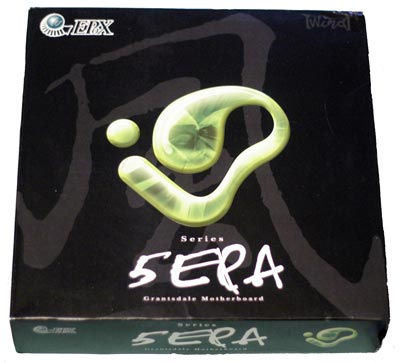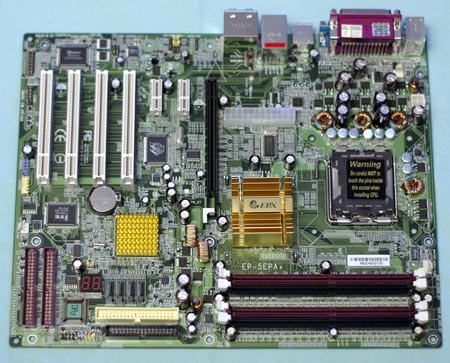915 Motherboard Roundup: Socket 775 for the Rest of Us
by Wesley Fink on December 7, 2004 12:25 AM EST- Posted in
- Motherboards
Epox 5epa+: Features and Layout
| Epox 5epa+ Motherboard Specifications | |
| CPU Interface | Socket 775 Pentium 4 (Prescott) |
| Chipset | Intel 915P/ICH6R |
| BUS Speeds | 100MHz to 400MHz (in 1MHz increments) |
| Realtime Turbo Mode | 202, 206, 210, 214, 220, 226 |
| DDR2 Speeds | Auto, 333, 400 |
| PCI Express Speeds | 100MHz to 150MHz in 1MHz increments |
| Core Voltage | -0.10V to +0.2125V in 0.0125V increments |
| DRAM Voltage | +0.1V to +0.7V in 0.1V increments |
| Memory Slots | Four 184-pin DDR Slots Dual-Channel Unbuffered Memory to 4GB |
| Expansion Slots | 1 PCIe x16 Slot 2 PCIe x1 slot 4 PCI Slots |
| Onboard SATA/RAID | 4 SATA 150 drives by ICH6R Can be combined in RAID 0, 1, Intel Matrix |
| Onboard IDE/RAID | One Standard ATA100/66 (2 drives) Plus 4 ATA133/100/66 drives by IT8212F ITE drives can be combined as RAID 0, 1, 0+1 |
| Onboard USB 2.0/IEEE-1394 | 8 USB 2.0 ports No FireWire Ports |
| Onboard LAN | Gigabit PCI Ethernet by Marvell 88E8001 |
| Onboard Audio | AC'97 2.3 Realtek ALC850 8-Channel with SPDIF |
| Tested BIOS | M265 |
Just before we completed the 915 roundup, Epox shipped us their newest version of the 5epa+ motherboard. Epox is well known for fast motherboards that overclock well, so we had high expectations of the performance of overclocking capabilities of this latest Epox board. The packaging is flashy with a large black package and standout graphics.

The Epox that we tested was the 5epa+ version, which included the RAID version of the ICH6R south bridge. While it was a pleasure to see ICH6R available as an option on the Epox 915, it was a disappointment to see some of the other choices that were made to keep prices down. First, the Intel High Definition audio has been replaced by an AC'97 2.3 Realtek ALD850. The 850 is a capable 8-channel audio codec, but it is certainly not the equivalent of Intel Azalia HD audio. We wish that Epox had found a way to keep HD audio like others here have done with boards that will sell in a similar price range. Next, Gigabit LAN is a nice feature, but this Gigabit LAN rides the slower PCI bus instead of the PCIe bus that could have provided better performance. When attached to PCI, there really isn't much advantage to Gigabit LAN over 10/100 LAN. Some will argue that none of us really need Gigabit LAN right now when broadband is hardly constrained by 100 LAN. However, if you need or want the advantages of Gigabit LAN, you won't find them on a Gigabit LAN saddled with the slower PCI bus. Last, there are no Firewire ports on the Epox. If you need them, look elsewhere, but for most, the missing Firewire ports really won't matter very much.
It is a good thing that Epox also noticed that 2 IDE devices would be very limiting for some users of the 5epa+. To correct this potential handicap, Epox added an ITE 8212 controller that provides support for four additional IDE devices.
Epox does not disappoint in the controls and ranges available for tweaking the 5epa+ in BIOS. The +0.7V maximum memory voltage translates into 3.3V from the stock 2.6V for the DDR memory supported by the Epox 915. This should be a range that will satisfy most memory overclockers. CPU voltage is also a generous range from a slight underclock (for cooler operation) to a +0.2125V overclock. This translates into 1.60V maximum with a current Prescott Socket T CPU.

When we first looked at the Epox, we recognized the unusual layout from our review of the Biostar P4TGP 775. The boards are not identical, features are a little different, but the 20/24-pin power connector is badly placed in the center of the board on both. Be careful when connecting the bulky power cable because it has to be routed around and behind the processor. The 12V 4-pin connector is better placed along the top edge of the board. All the IDE and floppy connectors, those driven by the chipset as well as those supported by the ITE controller, are located near the lower right edge of the board, below the midline. This is not a favorite location, but it still works fine with most board designs. With the diagnostic LEDs, SATA ports, and BIOS also located in this same area, it becomes a very busy quadrant. You need to plan cable routing to make sure that everything is still visible and/or accessible after the board is installed.
The 4 DIMM slots are also quite tight to the PCIe video slot plane. However, they are set further back than on most board designs, so they will only interfere with changing memory when you are using a very large video card.










26 Comments
View All Comments
Live - Tuesday, December 7, 2004 - link
Sorry Didn't see your reply before I posted Wesley.Sure there is some value to be had but not "outstanding". I still don't agree with you but I guess my mind is made up. Intel needs to come out with something new before I go back.
As a roundup it was very good reading tough. I can't wait for the next AMD roundup to hit AnandTech.
Live - Tuesday, December 7, 2004 - link
#12"The P5GD2 is an expensive motherboard, at about $240 on the web, but you can get almost all the same features in the P5GD2 Deluxe for about $50 less."
Thats expensive to me. Compare that to the 134.99 for the 939 Gold Editors Choice winner "MSI K8N Neo2 Platinum"
But thats not the point. If the 915P was substantially cheaper then a 939 system you might call it value for money but is it not. Mind you a 939 board is generally not cheap either but at least it delivers in comparison.
The CPU used in the review that hardly beat the much cheaper 3500+ had a max overclock of 14% and I bet you would find it hard to reach that high without the CPU overheating and start throttling http://www.anandtech.com/news/shownews.aspx?i=2345...
LGA775 CPUs does not offer great overclocking headroom compared to the much cheaper earlier Intel platforms or AMD for that matter. Sure they still overclock but nothing that we haven't seen before at higher cost and temperature. Again not what I would call outstanding.
Wesley Fink - Tuesday, December 7, 2004 - link
#11 - We just ran the 3500+ benchmarks in the same configuration this morning, and we do agree that the 3500+ is a particularly good value in performance for the dollar. However, the larger picture of prices of AMD CPUs compared to Intel show the Intel processors are a good, if not outstanding, value.Our conclusion was based on Anand's value analysis in the 3.46EE/1066 launch review at http://www.anandtech.com/cpuchipsets/showdoc.aspx?... There he compared the 3800+ at over $600 to a Intel 560 3.6GHz at about $450 and found the 3800+ the winner but probably not a big enough winner to justify the price premium for the 3800+. At that time, there was no 570 (3.8GHz) and the 3.6 was the fastest Intel CPU unless you considered the $1000+ Xeon-based EE processors. Price changes continue, and with them the value relationships do change.
A quick check of prices today shows
Intel 520(2.8GHz)- $160 AMD 2800+(754) - $128
Intel 530(3.0GHz)- $180 AMD A64 3000+ - $152
Intel 540(3.2GHz)- $220 AMD A64 3200+ - $194
Intel 550(3.4GHz)- $282 AMD A64 3400+ - $269
Intel 560(3.6GHz)- $455 AMD A64 3500+ - $270
Intel 570(3.8GHz)- $795 AMD A64 3800+ - $630
AMD A64 4000+ - $716
AMD A64 FX55 - $812
With current prices we would have to agree that there is really no great value advantage to Intel any more. But there is good value in the Intel processors from 2.8GHz (520) to 3.6GHz (560). Certainly the 4000+, at $80 less than the 570 and faster performance, and the FX55 at about the same price as 570 and significantly faster in most benchmarks, are better value at the top. But we still stand by Intel being good value in the middle.
deathwalker - Tuesday, December 7, 2004 - link
"outstanding value and performance for your buying dollar" ?????????? at $240 for a Mobo?..I guess I need to retake Economics 101...Bah...Intel just continues to shot themselves in the foot. A side note not related to this review..Dell must be deep inside of Intel's pocketbook with there contiued refusal to market AMD based products.danidentity - Tuesday, December 7, 2004 - link
#11 - 915P motherboards are not expensive. They are equal or cheaper in price than socket 939 A64 motherboards.LGA775 CPUs offer great overclocking headroom if paired with the right board. Intel CPUs have traditionally have had more OCing headroom than AMD chips. That still holds true, for the most part, today. Especially when talking about the low-end chips, like the 2.8GHz.
Live - Tuesday, December 7, 2004 - link
I'm sorry but I don't see the "outstanding value and performance for your buying dollar"Expensive Motherboards and CPUs with little overclocking headroom compared to the Athlon 64 competition. How does that translate to excellent value and performance? even the much cheaper 3500 comes out on top on most benchmarks.
Sure there are niche markets where the Intel platform excels but for the big majority of us AMD is where its at right now.
I don't think this review is in sync with your conclusion so either list some valid arguments for your point (Since its not there in the benchmarks) or edit the conclusion.
danidentity - Tuesday, December 7, 2004 - link
Wesley, thanks for including tests from a more comparable AMD CPU. Listening to your readers is always appreciated.Wesley Fink - Tuesday, December 7, 2004 - link
#4,#5,#6 - The Athlon 64 results with the FX55 were included for Reference, and not direct comparison. However you do make a good point.The closest A64 we had in the lab to a 3.6GHz 560 was the 3500+ based on the 90nm process. This should provide an advantage to the Intel 560. Since there are complaints here the FX55 is too high end, these new tests tilted toward Intel should balance the playing field. The 3500+ costs about $265 and the Intel 560 (3.6GHz) is about $455, so the 560 is about 70% more expensive than the 3500+.
The added 3500+ benchmarks were also an opportunity to test with the SAME ATI X800XT PCIe we used in benchmarking the 915 boards. Enjoy!
Color codes have been updated and there are now 3500+ results on the Gigabyte nForce4 with the ATI X800XT PCIe in all benchmarks.
Original plans were to include the Intel 570 in this roundup, but much of the testing was already done when the Intel 3.8GHz CPU was launched. This Intel 3.8 is priced at around $800, which is very close to the FX55. You can see how it compares to the FX55 in performance in Anand's launch article at http://www.anandtech.com/cpuchipsets/showdoc.aspx?...
CrystalBay - Tuesday, December 7, 2004 - link
It's a pity that all these 4 dimm slot, dual channelMB's have such a rough time doing it. Imagine trying
to run 4 1GB dimms in DC, this goes for ddr1 as well 2.
Glassmaster - Tuesday, December 7, 2004 - link
Now that Northwood and 865/875 are on the way out, only a fool would buy Intel.Glassmaster.